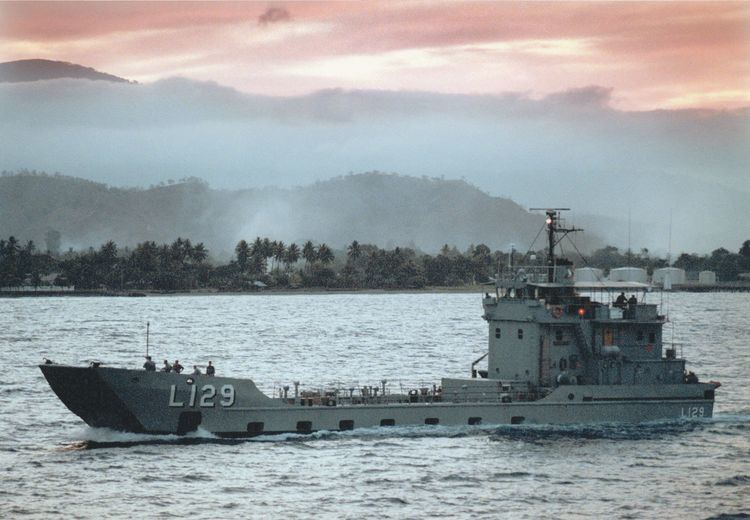Name Tarakan Commissioned 15 June 1973 Construction started 12 December 1971 Length 44 m | Laid down 12 December 1971 Decommissioned 20 November 2014 Launched 16 March 1972 Weight 321.1 tons | |
 | ||
Namesake The Allied recapture of Tarakan Builder Walkers Limited (Maryborough, Queensland) | ||
HMAS Tarakan (L 129) was a Balikpapan-class heavy landing craft of the Royal Australian Navy (RAN). One of eight vessels built by Walkers Limited, Tarakan (named after the Australian landing at Tarakan during World War II) entered RAN service in 1973. During the vessel's career, Tarakan was deployed post-Cyclone Tracy as part of Operation Navy Help Darwin, undertook various surveying operations, was placed in reserve between 1985 and 1988, relocated an overpopulation of Tridacna gigas clams, was part of the INTERFET peacekeeping taskforce, and participated in a Pacific Partnership humanitarian deployment. Tarakan was decommissioned from Australian service in 2014, and is to be transferred to the Philippine Navy in 2015.
Contents
Design and construction
The eight-vessel Balikpapan class was ordered as a locally manufactured replacement for the Australian Army's LSM-1 class landing ship medium and ALC 50 landing craft. They are 44.5 metres (146 ft) long, with a beam of 10.1 metres (33 ft), and a draught of 1.9 metres (6 ft 3 in). The landing craft have a standard displacement of 316 tons, with a full load displacement of 503 tons. They were propelled by two G.M. Detroit 6–71 diesel motors, providing 675 brake horsepower to the two propeller shafts, allowing the vessels to reach 9 knots (17 km/h; 10 mph). The standard ship's company is 17-strong. The Balikpapans are equipped with a Decca RM 916 navigational radar, and fitted with two 12.7 millimetres (0.50 in) machine guns for self-defence.
The LCHs have a maximum payload of 180 tons; equivalent to 3 Leopard 1 tanks, 13 M113 armoured personnel carriers 23 quarter-tonne trucks, or four LARC-V amphibious cargo vehicles. As a troop transport, a Balikpapan class vessel can transport up to 400 soldiers between a larger amphibious ship and the shore, or embark 60 soldiers in six-berth caravans for longer voyages. The vessel's payload affects the range: at 175 tons of cargo, each vessel has a range of 1,300 nautical miles (2,400 km; 1,500 mi), which increases to 2,280 nautical miles (4,220 km; 2,620 mi) with a 150-ton payload, and 3,000 nautical miles (5,600 km; 3,500 mi) when unladen. The flat, box-like keel causes the ships to roll considerably in other-than-calm conditions, limiting their ability to make long voyages.
Tarakan was laid down by Walkers Limited at Maryborough, Queensland on 12 December 1971, launched on 16 March 1972 and commissioned into the RAN on 15 June 1973.
Operational history
Following the destruction of Darwin by Cyclone Tracy during the night of 24/25 December 1974, Tarakan was deployed as part of the relief effort; Operation Navy Help Darwin. The ship sailed from Brisbane on 27 December, and arrived on 13 January.
In 1978, the LCH performed hydrographic surveys of Port Clinton, Queensland.
Tarakan was placed in reserve on 6 September 1985, one of three landing craft decommissioned for economic reasons. She was reactivated in 1988.
From May 1992 to April 1993, Tarakan was used by the Great Barrier Reef Marine Park Authority to relocate an overpopulation of Tridacna gigas clams from Orpheus Island to Grub Reef. Tarakan was seconded to Operation Beachcomber on several occasions between 1991 and 1995 for hydrographic duties.
In November 1997, Tarakan and Labuan delivered humanitarian supplies to drought-stricken areas in northern Papua New Guinea.
Tarakan was deployed to East Timor as part of the Australian-led INTERFET peacekeeping taskforce during 1999 and 2000. She was attached to INTERFET on two occasions; 30 October to 8 December 1999, and 13 January to 16 February 2000. Following an overhaul of the RAN battle honours system, concluded in March 2010, Tarakan was awarded the honour "East Timor 1999–2000" for these deployments. Tarakan and sister ship Balikpapan returned to East Timor in May 2006 as part of Operation Astute. Tarakan also deployed numerous times in support of Operation Bel Isi II (Peace Monitoring Group on Bougainville) and Operation Anode (Regional Assistance Mission to the Solomon Islands).
In 2010, Tarakan and Labuan participated in the Pacific Partnership humanitarian deployment. During June and July 2012, Tarakan was used to move personnel and stores to remote communities to facilitate the 2012 Papua New Guinea election.
In October 2013, Tarakan participated in the International Fleet Review 2013 in Sydney.
After participating in Exercise Croix Du Sud off New Caledonia, Labuan and Tarakan delivered humanitarian supplies to remote coastal settlements in the Solomon Islands in September 2014 as part of Australian support efforts in the region.
Decommissioning
Tarakan, along with Labuan and Brunei, were decommissioned on 20 November 2014.
Tarakan was refurbished and fitted with new safety and navigation equipment, prior to donation to the Philippine Navy. Hand-over of the vessel was originally due for 17 May 2015, but this did not occur. Instead, the Philippine Navy took possession of the vessel on 23 July, with the ships commissioned in Australia as BRP Batak also on the same day. The ship then sailed to the Philippines, with a formal christening on arrival in early August.
